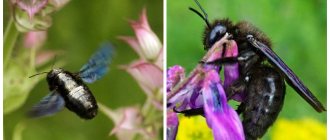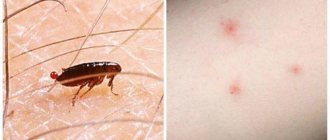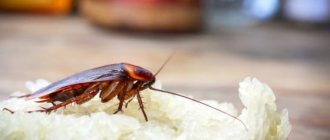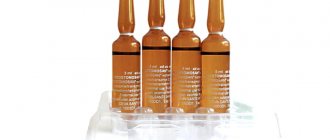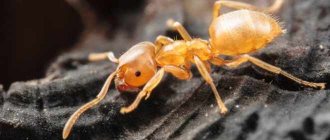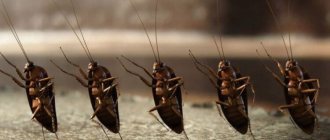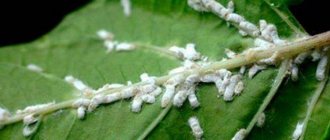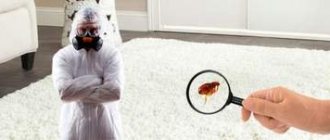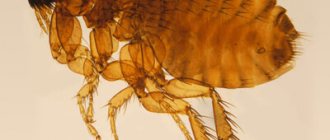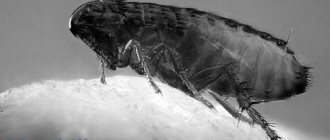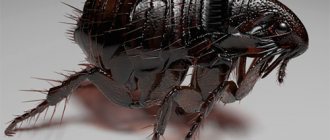Blood-sucking insects have accompanied people since the beginning of time. And even in the modern world, full of innovative technologies in various industries, getting rid of annoying parasites is an impossible task.
Fleas are a common type of insect that causes a lot of trouble for people and pets.
How dangerous are fleas to humans?
Even though fleas do not live on humans, they pose a serious health hazard. Insects feel comfortable parasitizing animals whose thick fur provides them with reliable shelter. But when the population of parasites becomes very large and the food obtained from animals is no longer enough or the fleas simply find themselves in close proximity to a person, they bite him.
Flea saliva contains many chemical compounds that are allergens. Therefore, the bite accordingly provokes an allergic reaction: irritation and swelling of the skin, itching, and in severe cases, fever, difficulty breathing, swelling of the larynx.
Bites
Parasites are carriers of pathogens, some of which are deadly. After a flea bite, a person can get sick:
- plague;
- typhus;
- encephalitis;
- hepatitis;
- salmonellosis;
- anthrax;
- tularemia.
Many individuals carry worm eggs. If you accidentally swallow an insect, you can become infected with helminthiasis.
Main features of fleas
Small blood-sucking insects that parasitize warm-blooded animals have tiny sizes from 1 to 5 mm depending on the species. The flea's body is flat and flattened on the sides, its shell is equipped with bristles and tenacious hairs in order to cling to fur and clothing.
The insect has three pairs of limbs, adapted for rapid movement and jumping over enormous distances (up to 20 cm), given the size of the parasite. Fleas parasitize not only cats, dogs and rats, but also birds. Therefore, they can also be found on domestic parrots.
Flea bites are very painful and cause the following consequences:
- Severe itching, inflammation of the skin;
- Allergic reactions;
- Severe diseases: hepatitis, plague, salmonellosis, tularemia, typhus, etc.
Considering the danger of infection with these diseases, it is necessary to take measures to cleanse your home of fleas as soon as possible.
Causes of fleas in the house
Since fleas need fresh blood to reproduce, their habitat is directly related to animals and birds. Parasites can live both in the fur or feathers of the host, and in the vicinity of it, for example, in a burrow, nest or litter (if we are talking about a domestic animal).
Since the optimal conditions for the development and residence of parasites are warmth and humidity, they actively colonize human homes. The most common answer to the question of where fleas come from at home is that pets brought them. But there are many other ways insects can enter a house or apartment.
Where do fleas come from in the city?
There are no fewer fleas in cities than in rural areas. After all, they do not need special conditions to live, the main thing is that there is food and shelter. Insects can live in lawn grass, in a bird's nest, in vacant lots and parks, in basements and attics. Parasites do not have to starve, since there are many stray animals on the streets.
With the onset of autumn, insects either fall into suspended animation, in which they can survive until the onset of warm weather, or try to settle in a warmer place. This explains where fleas come from in residential buildings, warehouses, and stores.
Where in a private house or country house?
The main reason for the appearance of fleas in a country house is animals. These can be domestic dogs and cats or farm animals and birds that are bred by the owners (for example, rabbits, sheep, chickens, ducks, turkeys). Insects can get into the house with a pet, or they can be brought on clothes or shoes by a person who has been in contact with infected animals.
Small black parasites often appear in a country house - these are rat fleas that live in the fur of rats and mice living in the underground or basement. Earth fleas, their eggs and larvae enter the house on the soles of shoes or on the paws of animals.
Where in the apartment?
There are many reasons for the appearance of fleas in an apartment. Most often, parasites enter an apartment in the following ways:
- the pet brought parasites after a walk;
- a person himself brought insects into the apartment after petting a stray dog or kitten on the street;
- parasites enter the apartment on the clothes or shoes of household members;
- fleas enter apartments located on the ground floor from the basement, and apartments on the upper floors from the attic;
- insects can move from apartment to apartment throughout the house through the ventilation system, so you shouldn’t be surprised that fleas appeared on the 5th or 10th floor.
It should be taken into account that fleas are more often found in apartments that are heavily cluttered and kept in unsanitary conditions.
Why are there fleas in the apartment if there are no animals?
As already mentioned, fleas need to drink blood to develop and reproduce. Therefore, the risk of their occurrence is significantly increased by animals living in the apartment. But even if there are no pets, fleas still appear in the apartment. For example, a neighbor's dog may leave several fleas or larvae on the doormat, which then migrate into the apartment on the shoes of someone in the household.
Fleas in the apartment
If one of the neighbors poisoned the parasites, then the survivors may enter the apartment in search of a safe place to live. Bloodsuckers can enter an apartment with purchased furniture or clothing if the items were previously stored in a warehouse infested with insects. Parasites will provide themselves with fresh blood by attacking apartment residents.
Methods of combating wingless parasites
The success of pest control largely depends on the right product. Conventionally, all anti-flea substances can be divided into two groups - killing and repelling. The first include toxic drugs that destroy adult colonies. Unfortunately, eggs and pupae are very difficult to eliminate. The second group consists of strong-smelling substances that force fleas to look for a new home with a more pleasant aroma.
Chemicals
Modern household chemicals take into account almost all problems that arise in the home. Therefore, feel free to go to the store and choose a special anti-flea product for your apartment. Carefully study the packaging and select the appropriate substance. The table provides an overview of the most popular chemistry.
Table - Chemicals for fleas
| Means | Advantages | Flaws |
| “Clean house” with chamomile for spraying | — Effectively and quickly kills adults; — easily eroded when windows are open; - not too toxic; — penetrates into cracks, covers large areas; — leaves no marks or stains; - valid for 12 hours with closed windows and doors | - Has an unpleasant odor; - does not destroy eggs and pupae, therefore requires repeated application |
| Powdered dust “Clean House” | — Easily and effectively destroys insects; — for convenience, diluted in water or used dry; — easily penetrates even into hard-to-reach places; - used on the floor and furniture; — quickly erodes (12 hours is enough); — does not leave stains; - also used as a prophylactic agent | — Has a pungent odor; - requires repeated application to kill new generations of insects |
| "Dichlorvos" for spraying | — Gives high efficiency, completely destroys the colony; - has an affordable price; — modern aerosol “Neo”, “Eco” is practically odorless; - fades away gradually, lasting for 2 weeks | — Requires the use of protective equipment (toxic); - harms domestic animals (requires their removal from the house for a while)" |
| "Karbofos" | — Non-toxic to humans; — effectively destroys the entire colony of insects; — easily diluted with water; - retains toxic properties for 2 weeks; - has low cost | — Has a strong unpleasant odor; - practically does not erode from furniture upholstery |
| "Flea spray" | — Completely destroys not only fleas, but also dust mites; — kills adults, larvae, pupae, eggs; — the effect lasts for 6 weeks, destroying subsequent generations of insects | — Suitable only for processing porous, soft surfaces - carpets, mattresses, bedding; - has a pungent odor; - has a high price |
| "Raptor" | — Gives a quick effect after just 1 application; - has a pleasant smell; — easily penetrates into all crevices; - has an affordable price | Requires the use of a mask (toxic) |
| Chalk (“Clean House”, “Mashenka”, “Brownie”) | — Kills different types of insects in the house; - used without preliminary preparation (lines are drawn) or in powder form (needs to be crushed); - stays on the surface for a long time without losing its toxic properties for 4-6 weeks, one piece is enough for 30 square meters; - has a low cost | — Causes poisoning, toxic to people and domestic animals; - often used as a prophylactic agent; - over time, insects develop immunity |
To avoid exposing your home to chemical treatments, purchase an ultrasonic repeller. Choose only professional devices, for example, Pest Reject or Typhoon LS-500. Some types of devices get rid of not only insects, but also rodents. The device does not work instantly. It will take at least a couple of weeks to feel the effect.
Traditional methods
You can completely get rid of fleas in the house only with strong chemicals after completely treating the room. However, products that can be found in almost every home will help pre-wash floors, clean carpets, furniture, animals, while repelling an adult colony of insects. The products have an unpleasant odor that fleas do not like.
Some substances, such as essential oils with a strong odor, can be used as a flea preventative. It is enough to treat possible places where insects accumulate with oil every week. If parasites have infested a private home, it is recommended to plant tansy in the area next to the windows and door. Plants with yellow inflorescences will decorate the area, and the smell will repel insects. Read more about the use of popular folk remedies in the table.
Table - Home methods for getting rid of fleas
| Means | What to do |
| Tar soap for fleas | — Wash floors and other surfaces with soap; - wash clothes in soapy water |
| A mixture of baking soda and salt in equal parts | — Pour the mixture onto the carpet and other fleecy surfaces; - leave overnight, vacuum |
| Herbal mixture of wormwood, mint, tansy, chamomile, laurel | — Brew the herbs, making a steep infusion; — spray the “favorite” places of fleas; - repeat the procedure every week; - wash your pet with infusion; - spread fresh grass around the apartment |
| Garlic | — Place the garlic cloves in different corners of the room; - crush for a brighter aroma; - prepare a strong garlic solution, spray the room after a couple of hours |
| Pine or spruce sawdust | Place fresh aromatic sawdust under your pet's bedding (you can replace it with fresh lemon or orange peel) |
| Ammonia, vinegar, dish soap, washing powder | Add one of the products to the water when washing the floor to repel insects with a strong smell |
| Kerosene | — Pour 100 ml of water into a bucket, wash the floor and baseboards; - repeat for prevention 1-2 times a week |
| Boric acid | — Sprinkle carpets, furniture, mattress, floor in an even layer; - leave for a day, then vacuum |
| Creolin | — Dilute the substance in water to obtain a 3% solution; - use eye and respiratory protection; - wash the floor, baseboard, walls with the solution; - leave for several hours, rinse off; - heat the solution to about 60°C, wash your pet |
According to reviews, the effectiveness of the product depends on endurance and concentration. Do not make too weak solutions, but also do not overdo it, otherwise not only insects, but also household members will suffer. Use the white sheet to determine the effectiveness of the product. After the procedure, place the paper under the bed, near the sink, or baseboard. After a few hours, assess the number of fleas on the leaf.
Signs of fleas at home
It is quite easy to determine that fleas have appeared in an apartment or house. You can remain in the dark at first, while there are still few insects and they are not very active, but every day the signs that parasites are neighboring you become more and more obvious:
- the behavior of pets changes - they become restless, irritable, often itch, and sores appear on the skin;
- household members have bite marks on their bodies (most often on their legs below the knee), which itch and do not go away for several days;
- Small dark dots were noticed on the floor, furniture, linen or soft toys.
If at least one of the signs is noticed that confirms that fleas live in the apartment, it is necessary to urgently take measures to destroy them.
Habitats
A common misconception is that fleas live on the body of their prey. This is far from true. Fleas jump onto the body of an animal only to eat; the rest of the time they prefer to live in more comfortable conditions. Various types of blood-sucking parasites choose comfortable places to live in the apartment.
Earth and sand fleas prefer to stay close to the floor. Therefore, most often their nests are located behind baseboards, in carpets and paths. Cat and dog fleas are found in the animal's bedding and can sometimes be found in soft toys.
How to find a flea nest at home?
Finding where fleas are hiding can be quite difficult. Firstly, because if there are parasites in the house, they very quickly disperse throughout all the rooms. Secondly, the parasites are very small, jump well and prefer secluded places, so it is quite difficult to notice them.
Of course, the first thing you need to do is examine your pet; perhaps fleas are hiding in its thick fur. But if parasites are found on a dog or cat, you should not calm down. This is definitely not the only place where fleas have settled, so we need to continue the search.
The most likely places where you can find insects in an apartment:
- carpets, bedding;
- cracks and crevices in the floor, walls;
- soft toys, upholstered furniture;
- behind the baseboards;
- behind peeling wallpaper or peeling wall panels.
When starting your search, you need to take into account that fleas can live in absolutely all areas of the apartment, be it the bathroom or the bedroom.
Precautionary measures
To prevent the appearance of parasites, you need to clean your apartment more often and ventilate the rooms. Of course, these are general and familiar tips, but they really help. The condition of the house is also the responsibility and consciousness of the residents. The basement serves as a breeding ground for fleas. It is necessary to inform utility services more often and require disinfection of the basement and waste disposal chute, if it is located in the house.
It seems that parasites attacking residential premises are a thing of the past. In fact, the problem remains relevant today. Simple rules and tips will help you avoid an unpleasant neighborhood with fleas in your apartment.
How long do fleas live?
The average lifespan of a flea is 2-3 months. This indicator is relevant for ideal conditions, when the temperature and humidity of the environment are most suitable for a particular type of insect. If, for example, the air temperature rises significantly, the flea dies within 3-4 weeks. But cold, on the contrary, increases the lifespan of the parasite; a flea can live 1.5 - 2 years.
Flea
Fleas living on animals have a harder time surviving. Most parasites die when a cat or dog practices hygiene.
Attention! Oddly enough, the lack of food also increases the life expectancy of parasites. Without food, fleas will not reproduce, but they can survive for months.
Doggystyle
They are less common than felines and do not reproduce as quickly, but they successfully infect all four-legged animals that come their way. Like all other types of pests, dog parasites have a flattened body and dark color .
Under a microscope, the insect's too-long hind legs attract attention. It is they who ensure jumping at distances that exceed the size of the parasite by a hundred times.
REFERENCE : The oldest jumping insect was found in fossilized amber, which is more than 55 million years old.
Dog fleas successfully prey on humans . This especially happens when the animal is heavily infected. Pets can pick up the pest from an infected dog during a walk, from a cat or rat, and even from a person whom the parasite was used for “transportation”.
Dog fleas
How to fight?
To remove fleas from your home, you need to start acting as soon as the insects are discovered. Only comprehensive measures will help, otherwise the parasites will remain and very soon they will make themselves felt again. To combat fleas, you can use modern pharmaceutical products and traditional methods.
To successfully get rid of parasites you must:
- carry out general cleaning (vacuum carpets, upholstered furniture, treat street clothes with a steam generator or have them cleaned, wash floors, get rid of dust, wash textiles and soft toys);
- treat pets with special anti-flea preparations, and subsequently, for preventive purposes, wear a flea collar or use other repellents;
- if there are a lot of insects, it is worth treating the room with an insecticide (it is advisable to choose a drug that affects not only adult insects, but also eggs and larvae, otherwise the procedure will need to be repeated).
To prevent fleas from returning, you should remember the following prevention measures:
- keep the home clean;
- avoid contact with street animals;
- wash your shoes after walking;
- regularly check your pets for parasites;
- use natural repellents in the apartment - herbs or essential oils.
By following these simple rules, the likelihood that fleas will return is significantly reduced.
Rat
There are European and southern representatives of this species. The former live on the fur of domestic rodents. They parasitize rats and mice in European countries. They are known carriers of rat tapeworm and carriers of plague.
Southern relatives are among the most dangerous in the world. By first biting a rat and then a human, the insect transmits murine typhus and bubonic plague .
Rat fleas
Flea repellents
When residents of a separate apartment are unable to destroy a flea outbreak, or when there are pets that can carry parasites on their fur, you can protect your home with effective and proven methods that repel fleas.
- Herbs - tansy, wormwood, mint, whose fresh branches or decoction have the ability to repel bloodsuckers, and they will not inhabit such a room.
- Essential aromatic oils - eucalyptus, cloves, mint, cedar, which have similar properties, will prevent fleas.
- Coniferous sawdust scattered indoors will also prevent parasites from occupying your home.
Important! With the help of these tricks, it will be possible to completely get rid of fleas only in the early stages of their appearance, since they do not lead to the death of the parasites, but only scare them off with their characteristic smell, which bloodsuckers cannot stand, which forces them to retreat back home.
Human flea development cycle
The life cycle of the human flea is similar to other species of wingless insects. The only differences are the laying of a huge number of eggs by the female (2000 in her entire life) and the parameters of adults.
Bloodsuckers go through 4 stages of development:
- eggs;
- larvae;
- cocoons;
- sexually mature individuals.
Having had enough, the female lays eggs in various places - bedspreads, wool, clothes, sofas, carpets, etc. Eggs mature in about two days.
After hatching, the larvae begin to actively absorb the excrement of adult insects and other waste. Pulex irritans go through several stages of development, and then they pupate.
To emerge from the cocoon, the parasite needs a favorable environment. Therefore, the time from the moment the egg develops to the hatching of a new individual can last from 15 days to a year.
